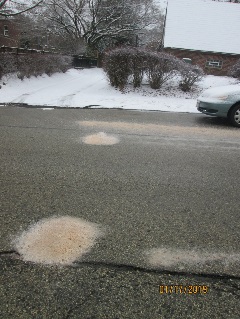The chloride levels in tiny Rock Creek – as it winds through Curtis Arboretum in Cheltenham Township, just outside of the city limits of Philadelphia – are disturbingly high.
My watershed work partner Chrissa Pedersen and I have been monitoring chloride levels in the creek for almost a year, supported and advised by the Izaak Walton League’s Winter Salt Watch staff. We expected high salt levels in the winter, when area roads were being salted during snow and ice storms. But much to our dismay, the chloride levels remained high right through the spring and most of the summer.
 My name is Geoffrey Selling and I’m a retired science teacher – and now, a Pennsylvania Master Watershed Steward.
My name is Geoffrey Selling and I’m a retired science teacher – and now, a Pennsylvania Master Watershed Steward.
Since I retired in 2015, I’ve been working on various watershed projects, monitoring area creeks and especially focusing on trying to improve the riparian buffer along Rock Creek in Curtis Arboretum. Rock Creek begins about a mile above the arboretum, just behind a supermarket that sits in a large parking lot with many big box stores nearby. Some of the creek’s water comes from springs, but much of it is groundwater, seeping in from the surrounding neighborhoods. Large amounts also come from the parking lots along the creek. Less than half a mile downstream from the “headwaters,” a large mall, surrounded by more big box stores and gigantic parking lots, contributes more water to this small stream. Rock Creek also receives water from nearby roadways, gas stations and suburban neighborhoods.
In addition to large amounts of trash and litter coming down the creek, a great deal of salt also finds its way into this urban stream.
 The roads and nearby parking lots are heavily salted during storm events. On several occasions, I’ve photographed large salt spills from careless truck operators.
The roads and nearby parking lots are heavily salted during storm events. On several occasions, I’ve photographed large salt spills from careless truck operators.
It is easy to make sense of the high chloride levels in winter. Their persistence in the spring and summer is more puzzling. We’ve wondered if some of the larger salt “spills” have been dampened by precipitation and have become “glued together,” thus remaining in place a long time. With each subsequent rainstorm, some of that clumped salt might dissolve and run off.
The nearby Stroud Water Research Center has been studying the high salt levels in our wider metropolitan area. One hypothesis put forward is that the salt is accumulating in the actual streambeds, under the sand, mud and debris in the creeks. This is still being explored.
As Chrissa and I have performed our monthly chloride tests, our eyes have been opened to this problem. Because our primary focus had been on the removal of invasive species and planting native trees and shrubs, we thought the monitoring of chloride was enough. We are now sufficiently troubled that we want and intend to “do” something.
We hope to get together with Cheltenham Township supervisors, some of the owners and managers of retail establishments and malls, and individuals involved in the local watershed organizations. A local high school’s environmental action club and other concerned students have also expressed interest in this work. The students are eager to talk to retailers and to go door to door talking to neighbors about reducing the amounts of salt being distributed.
All of this meeting and planning is in the near future. It hasn’t happened yet and none of us who are involved is an expert. But we feel we have to start somewhere, and we know that Winter Salt Watch will support this work with ideas, resources and guidelines.
Get started with Salt Watch